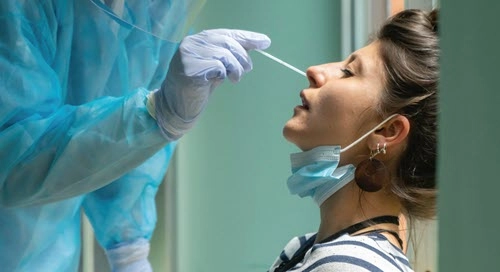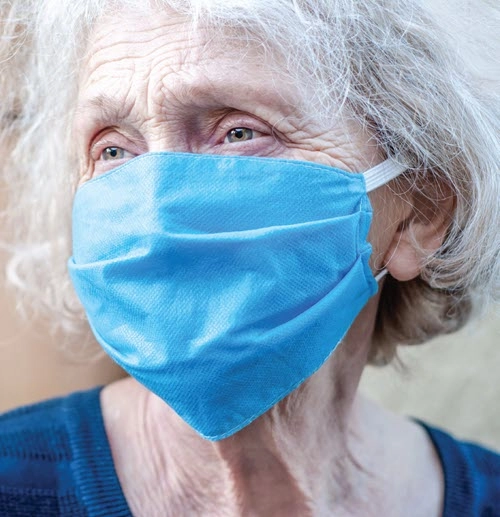MDS Alert
Note These New Tools and Relevant COVID-19 Updates
Know which red tape has been cut, and which guidance has evolved. The Centers for Medicare & Medicaid Services (CMS) is trying to make things easier for facilities amidst the pandemic by providing more guidance for testing for the SARS-CoV-2, the virus that causes COVID-19, as well as simplifying some of the backend administrative logistics of vaccinating residents. If you’re curious how your facility’s approach to vaccinating staff compares with others, read on for more information. Understand This Bundling Discretion Measure In a recent announcement, CMS stated it will allow some entities to be directly reimbursed for vaccinating skilled nursing residents, saying: “… in order to facilitate the efficient administration of COVID-19 vaccines to SNF residents, CMS will exercise enforcement discretion with respect to these statutory provisions as well as any associated statutory references and implementing regulations, including as interpreted in pertinent guidance (collectively, ‘SNF Consolidated Billing Provisions’). Through the exercise of that discretion, CMS will allow Medicare-enrolled immunizers, including but not limited to pharmacies working with the United States, to bill directly and receive direct reimbursement from the Medicare program for vaccinating Medicare SNF residents.” See the full notice online at www.cms.gov/medicare/covid-19/snf-enforcement-discretion-relating-certain-pharmacy-billing. Consider Ramifications of Paying Staff to Get Vaccinated Nursing facilities struggling with gaining staff buy-in for COVID-19 vaccinations may want to borrow a page from a Houston, Texas, hospital’s playbook. Houston Methodist is offering a $500 “hope bonus” to employees who agree to receive the vaccination, reports ABC News. Similarly, Northampton County in Pennsylvania is offering employees at Gracedale, the county nursing home, $750 each to get a COVID-19 vaccine, ABC News says. Other businesses are hopping on the money-for-vaccination bandwagon, too, with reports in national media outlets of Dollar General and Trader Joe’s grocery store paying employees to get vaccinated. The tactic comes with pros, cons, and ethical gray areas. For example, it may lead staff to think the vaccine is more dangerous than it is, medical ethicists warn. Conversely, there have been some reports of nursing homes firing staff who refuse to get vaccinated. The Janesville, Wisconsin, GazetteXtra reports that the local, county nursing home will lay off staff members who do not get vaccinated, but also notes that some area private nursing homes are not requiring vaccination. For more information on whether to make vaccination a mandate, see “Understand How COVID-19 Vaccines Might Impact NFs” in AAPC’s MDS Alert, Volume 19, No. 1. Know These Changes to Antigen Testing Recs The Centers for Disease Control and Prevention (CDC) has updated some of its guidance for antigen testing in long-term care facilities. Antigen testing allows a rapid turnaround for results, making it an important and helpful tool in identifying positive cases and preventing outbreaks. One major takeaway: “Asymptomatic people who test antigen positive should have a confirmatory test performed. Symptomatic people who test antigen negative should have a confirmatory test performed,” the CDC says. Resource: See this flowchart for a visually simplified way to figure out when to use antigen testing for symptomatic and asymptomatic residents: www.cdc.gov/coronavirus/2019-ncov/downloads/hcp/nursing-home-testing-algorithm-508.pdf. Keep an Eye on Care Compare Don’t forget that Care Compare, the newest iteration of Nursing Home Compare, has again began incorporating inspections that had been paused since the beginning of the public health emergency (PHE) in March 2020. Background: On March 23, 2020, CMS “suspended certain inspections, including standard, fire, and safety inspections, while also implementing a new focused infection control inspection process to concentrate on preventing the spread of COVID-19. CMS began posting the reports and findings from the focused infection control inspections through a link on the Nursing Home Compare website. Since certain inspections were suspended, CMS held the Health Inspection Rating domain of the Five Star Quality Rating System constant,” says David Wright, director of quality, safety & oversight at CMS. But some of the Care Compare ratings are based on data submitted directly by facilities, like MDS data and the information used to calculate claims-based quality measures. Although CMS adjusted or waived the timelines for submission, facilities still sent this information, and Wright says CMS analysis of both data sets indicated no issues in updating the corresponding measures on Care Compare. Find more information about the changes to the Five Star Quality Rating System at https://www.aapc.com/codes/coding-newsletters/my-mds-alert/quality-measures-test-your-knowledge-and-avoid-ratings-penalties-166376-article. Try This Tool for Waiver Submission If you’ve been suffering through the confusion or disorganization surrounding the 1135 waivers during the pandemic, some relief is now available. CMS has recently released a web-based portal dedicated to 1135 waivers, so you no longer need to email your waiver requests or inquiries. “If you or your organization have a question for CMS regarding a PHE, please visit the 1135 web-based portal to submit a PHE-related Inquiry. If you or your organization would like to request an 1135 waiver during a PHE, then also visit the web-based portal to submit your request,” says Karen L. Tritz, director for the survey & operations group at CMS, in a January memorandum. The portal went live Jan. 11, 2021 and is available to use now. Pay Attention to PPP Adjustments Paycheck Protection Program (PPP) Act borrowers were happy to welcome the eagerly awaited simplified loan forgiveness form for the program. The one-page form, which was required by the COVID-19 relief package signed into law Dec. 27, 2020, was still in the works when the Small Business Administration issued a Jan. 6 interim final rule implementing the law’s PPP provisions. As required by the 2021 Consolidated Appropriations Act, “only two dollar amounts are requested: the amount of the loan spent on payroll costs and the requested loan forgiveness amount,” says Tad Goodenbour with BKD, in online analysis of the new form. “The use of Form 3508S doesn’t grant automatic forgiveness of the full PPP loan,” Goodenbour cautions. “For loans in excess of $50,000, the full-time equivalent (FTE) reduction rules and the salary and hourly wage reduction provisions that can reduce the loan forgiveness amount are still applicable. These provisions aren’t applicable to loans of $50,000 or less.” Watch out: “In spite of its simplicity, it’s important to remember the SBA reserves the right to disapprove an application for forgiveness even if it’s filed on the revised Form 3508S,” Goodenbour adds. A link to the new form is at https://home.treasury.gov/policy-issues/cares/assistance-for-small-businesses — scroll down to the “3508S” entry posted Jan. 19 in the “For Borrowers” section. The form is one page, with six pages of instructions following.

MDS Alert
- CMS Roundup:
Note These New Tools and Relevant COVID-19 Updates
Know which red tape has been cut, and which guidance has evolved. The Centers for [...] - Surveys and Compliance:
Tick These Boxes for Pain Management
Prioritize the resident but know that surveyors are evaluating staff responses. As providers, nursing homes [...] - Quality Measures:
Test Your Knowledge and Avoid Ratings Penalties
Don’t miss these updates or the ways they reflect upon your facility. The Care Compare [...] - Check Your Answers Here
Determine whether your knowledge of the updates to the Five-Star Ratings System is up to [...] - Reader Questions:
Choose Correct Modifier for Medicare Billing
Question: I don’t understand the difference between the CR modifier versus the DR condition code. [...] - Reader Questions:
Don’t Use Aftercare Codes in This Instance
Question: What’s the most appropriate diagnosis code for a resident who ends up in a [...] - Reader Questions:
Aim for Specificity to Code Idiopathic Gout
Question: One of the residents on my wing is here for complications from gout, but [...]

